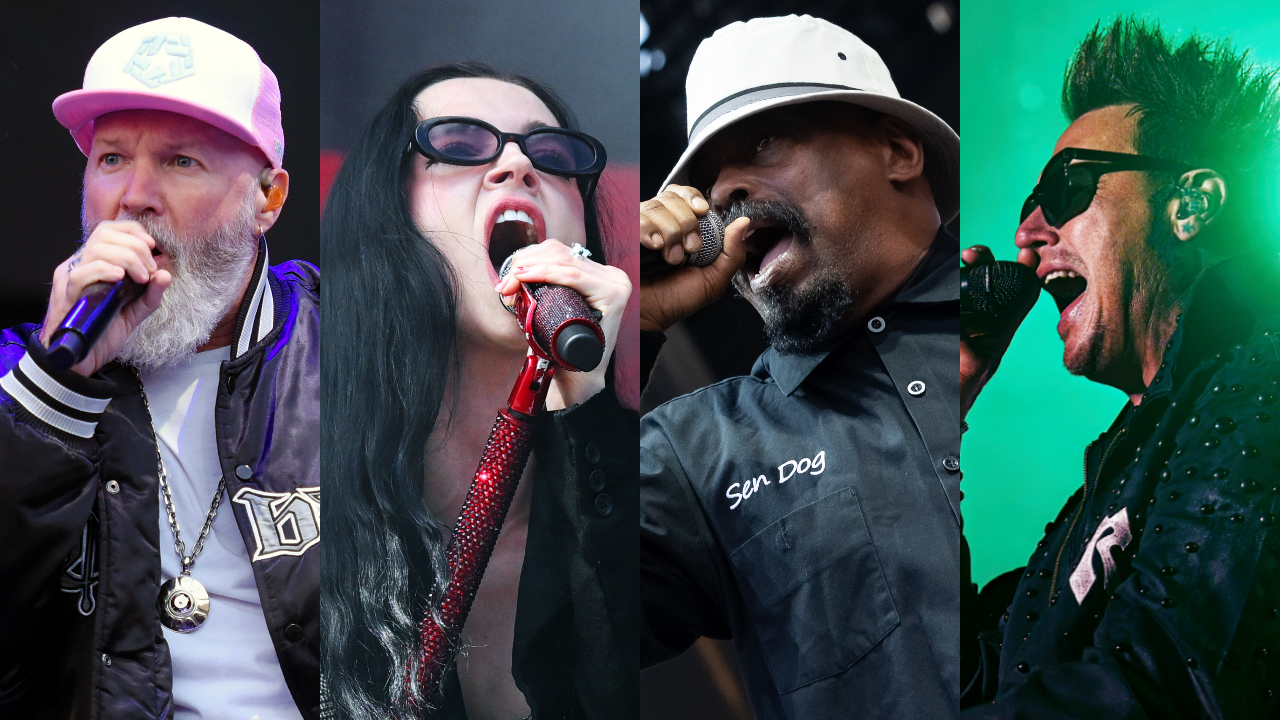Every PJ Harvey album ranked from worst to best
We examine and rank PJ Harvey's studio collections from worst to best

PJ Harvey is a musical chameleon, reinventing herself with each album, leading to early assertions that she was the ‘indie Madonna’. But the Dorset-born musician's transformations from record to record soon made comparisons to the mighty Madge seem short-sighted. The most cursory examination of her catalogue reveals early ragged indie recordings, experimentation with tone and electronics, raw and exposed 4-track and demo recordings, English folk songs, Gothic chamber pop and her recent multi-instrumental forays into the history of war.
Compiling a worst to best list for an artist who completely rewires her sound from album to album is a challenge, with many fans having very strong reasons for identifying with one iteration of her storied career over another. One thing that’s for certain is that Polly Jean Harvey is one of the greatest, most idiosyncratic artists England has ever produced. She is a national treasure and without her, the landscape of modern British music would seem a much less adventurous place.

9. Is This Desire? (1998)
With the greatest respect, we might have to get into a tussle with Ms Harvey at the first hurdle. The singer once told The Telegraph "I do think Is This Desire? is the best record I ever made—maybe ever will make—and I feel that that was probably the highlight of my career." In reality, doubling down on the atmospheric mood pieces based around keyboards, bass and electronics which were so successful on previous album To Bring You My Love often left for lumpen results (witness, the surely ironically titled Joy).
Assembled over the course of two long studio sessions with almost a year's gap between them, the album feels uneven and disjointed. Adding to the incoherence was Harvey’s exhaustion from the To Bring You My Love cycle and the emotional fallout from the collapse of a brief, stormy love affair with Nick Cave.
Is This Desire? is a typically fearless leap into new territory, but it’s little wonder that Harvey has not returned to this sound in the 24 years hence.
8. Uh Huh Her (2004)
After her biggest commercial success, with 2000's Stories from the City, Stories from the Sea, it seemed that Harvey wasn’t entirely comfortable in the position she found herself. She subsequently explained to Time Out magazine that she "wanted to get back to the earthy, rootsy, more dirty side of things" following her brush with the mainstream. Consequently, Uh Huh Her feels like it’s trying to antagonise and confront the listener, but more often than not, her sixth studio set comes across as a bunch of unfinished, rushed ideas (particularly strange considering there was a 4-year gap between albums).
Written during a period of enforced creative isolation, Harvey recorded and played every instrument on the album (bar drums, handled by long-time collaborator Rob Ellis), which lends the album a DIY-aesthetic that doesn’t always suit the songs. The scuzzy garage rock of Who the Fuck? sounds reedy and thin, a pale imitation of the acerbic music she made her name with. The Desperate Kingdom of Love, however, is essential.
The latest news, features and interviews direct to your inbox, from the global home of alternative music.
7. The Hope Six Demolition Project (2016)
There’s a common theme with the placing of these first three albums in this countdown; all three came off the back of very successful and critically acclaimed albums in Harvey’s career. The concept of her ninth album is intriguing, with Harvey drawing inspiration from time spent with photographer/filmmaker Seamus Murphy in poverty-stricken areas in Washington D.C., Kosovo and Afghanistan. As a result, like its predecessor, it’s an album that looks outwards rather than inwards, with Harvey adopting an observational lyrical approach rather than personal.
This approach is fine in theory, except it’s not entirely clear what Harvey is trying to say on The Hope Six Demolition Project, with its fractious vignettes never managing to find a solid conceptual whole. Thematic musical motifs such as saxophone squalls, call-and-response choruses and male vocals add some sense of an overarching theme, but they never converge to create anything cohesive. But maybe that’s the point: maybe confusion is the only logical reaction to the things that Harvey saw, as she endeavours to make sense out of things that simply don’t make sense.
6. Dry (1992)
Harvey’s seething, acerbic debut, Dry has lost little of the impact it had when unleashed on an unsuspecting public back in March 1992. PJ Harvey (very much a band at this point alongside drummer Rob Ellis and bassist Steve Vaughan) arrived fully formed, even if the recordings sounded a little rough around the edges.
The music on Dry twisted and convulsed in reaction to Harvey’s withering lyrics, particularly on the confrontational Plants and Rags and Happy and Bleeding, switching from desire to violence on a dime. Singles Dress and Sheela-Na-Gig added a playful quality whilst being no less abrasive, these two future classics committed to tape when Harvey was just 22.
In short, PJ Harvey entered the musical landscape with one of the most daring debuts in recent memory. Critics and fans responded in kind, with NME ranking Dry among its all-time greatest 100 albums just one year after its release and Nirvana's Kurt Cobain famously hailing it as one of his favourite records.
5. Rid of Me (1993)
Following a label bidding war which resulted in the trio signing to Island, Harvey hand-picked Steve Albini to record her second album, determined to keep things raw, ragged and edgy whilst bringing out the harsher aspects that might have been tempered on Dry. It was a match made in heaven, the dynamics of the title track immediately benefitting from Albini’s recording techniques.
Booked into a secluded Minnesota studio for two weeks in the middle of winter, the band and producer were completely isolated from the outside world, resulting in an intensity that is captured on tape. (Albini would revisit the studio in February '93 to record In Utero with Nirvana.) Released just 14 months after Dry, Rid of Me improved on almost every aspect of Harvey's debut, but it showed other sides to the musician too, with Missed being perhaps her most tender moment up to this point. Rid of Me is an astounding piece of art, but what Harvey would go on to do as a solo artist was something no-one could have prepared for.
4. Let England Shake
On her eighth album, Harvey inhabits the spirit of war correspondent, ploughing hours of work into researching the history of conflict. The key to Let England Shake is that at no point does Harvey tell us what to feel, but we inevitably come to our own conclusions.
The opening cry of ‘Goddam’ Europeans!’ on the excellent The Last Living Rose hides many different shades of subtext, especially in a post-Brexit Britain. Harvey adopted autoharp on several songs in order to keep her compositions fresh, an approach that works wonders on The Words That Maketh Murder and All and Everyone. She also adopted a different style of singing, affecting a haunted warbling ghostly cry which is particularly effective on England.
Let England Shake was voted the best album of the year in 16 different publications at the end of 2011 and it won Harvey her second Mercury Prize (to this day, she remains the only artist to have won two). Harvey would continue the conflict narrative on her next album The Hope Six Demolition Project, but Let England Shake is her most provocative and assured work on the subject.
3. Stories from the City, Stories from the Sea (2000)
Stories from the City, Stories for them Sea is PJ Harvey’s love letter to a New York that no longer exists, capturing as it does the hustle and bustle of The Big Apple pre 9/11. Harvey perfectly captures the confusion and chaos of the city on opening song Big Exit, but elsewhere you get a sense that her nine month escape to New York was reconditioning for the soul.
Several songs seem to depict a romantic relationship (Good Fortune, Beautiful Feeling, the wonderful You Said Something) with the Manhattan skyline being as intrinsic a character as Harvey’s lover. After the harsh, disturbing sounds she conjured for To Bring You My Love and Is This Desire?, Harvey wanted to create something lush, sumptuous and beautiful, and this album remains her most commercially accessible to date. It’s also one of her best.
2. White Chalk (2007)
Harvey’s seventh studio album is a Victoriana gothic masterpiece, her most haunting, chilling and quiet album to date. Composed mainly around piano, an instrument Harvey had never played before, the melodies are eerie lullabies, simple ditties that sound timeless. Most of the songs could have been composed at the turn of the 20th century, let alone the turn of the 21st.
Harvey sounds broken, a destitute Miss Havisham on the likes of The Devil, When Under Ether and The Piano, while the array of voices that conclude Silence is simply one of the most chilling and beautiful things she has ever recorded. Highlights are plentiful but White Chalk is at its best when consumed as a whole, like one deep, dark look into a woman’s psyche. Easily Harvey’s most under-rated album, it’s about time White Chalk was re-appraised.
1. To Bring You My Love (1995)
PJ Harvey’s first major re-invention also proved to be her most successful and alluring. Aiming to write her own versions of the blues standards and Captain Beefheart songs she had loved for years, Harvey re-emerged in the public eye with what she called her “Joan Crawford on Acid” look smeared on her face.
The biblical lyrical references giving a sense of the grandiose, To Bring You My Love interweaves a seductive blend of mood and melodrama. Within this framework, Harvey sings of crossing desert plains, borders and oceans and laying with the devil whilst cursing God above. To Bring You My Love feels dangerous, malevolent and often downright disturbing. Even the big MTV hit Down by the Water revolves round a sinister whispered refrain: "Little fish, big fish, swimming in the water / Come back here man, gimme my daughter."
The live shows changed too, with Harvey often emerging in elegant ball gowns, made up to the nines and with theatrical props in tow, a far cry from the raw and ragged Steve Albini authenticity of the Rid of Me era. Essentially, To Bring You My Love is the moment that this most compelling artist became whatever she wanted to be.
